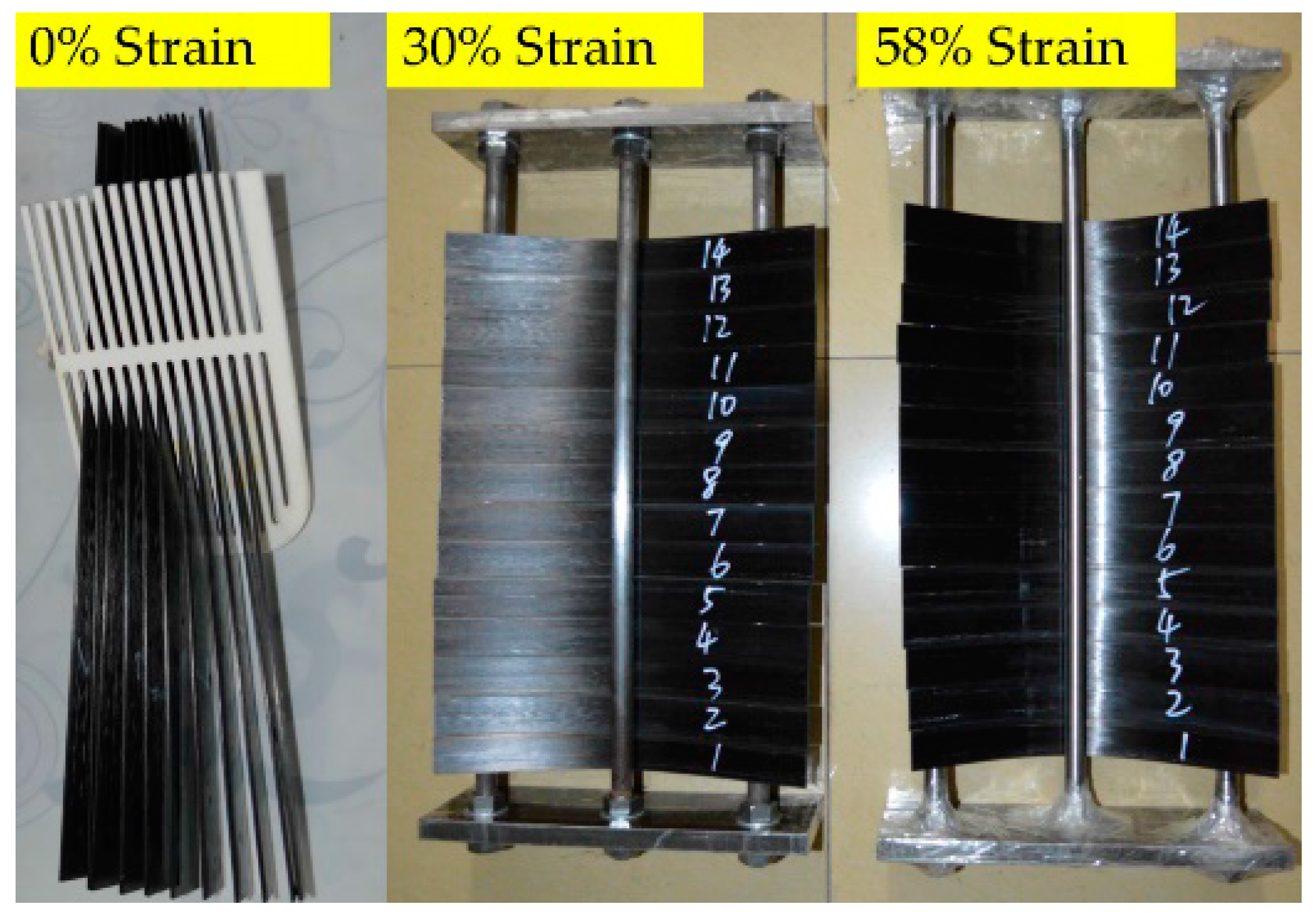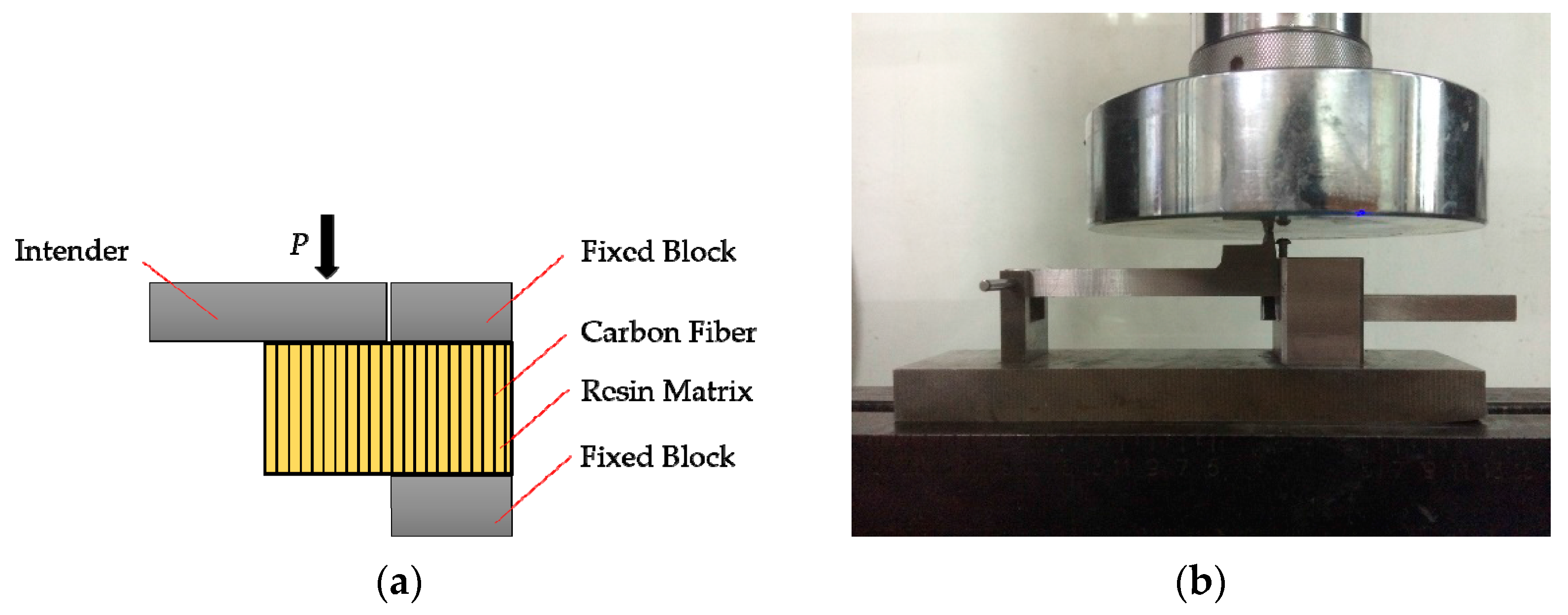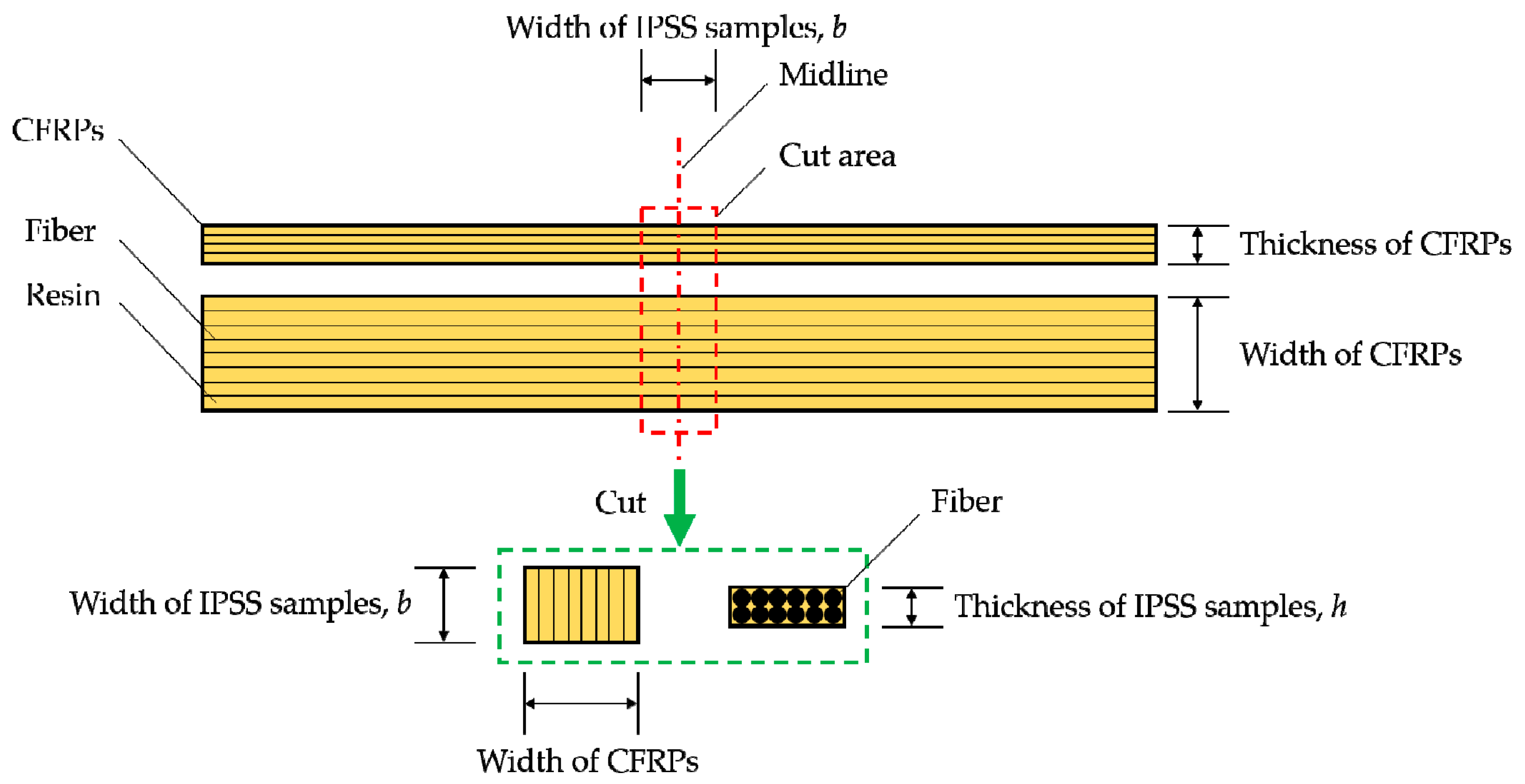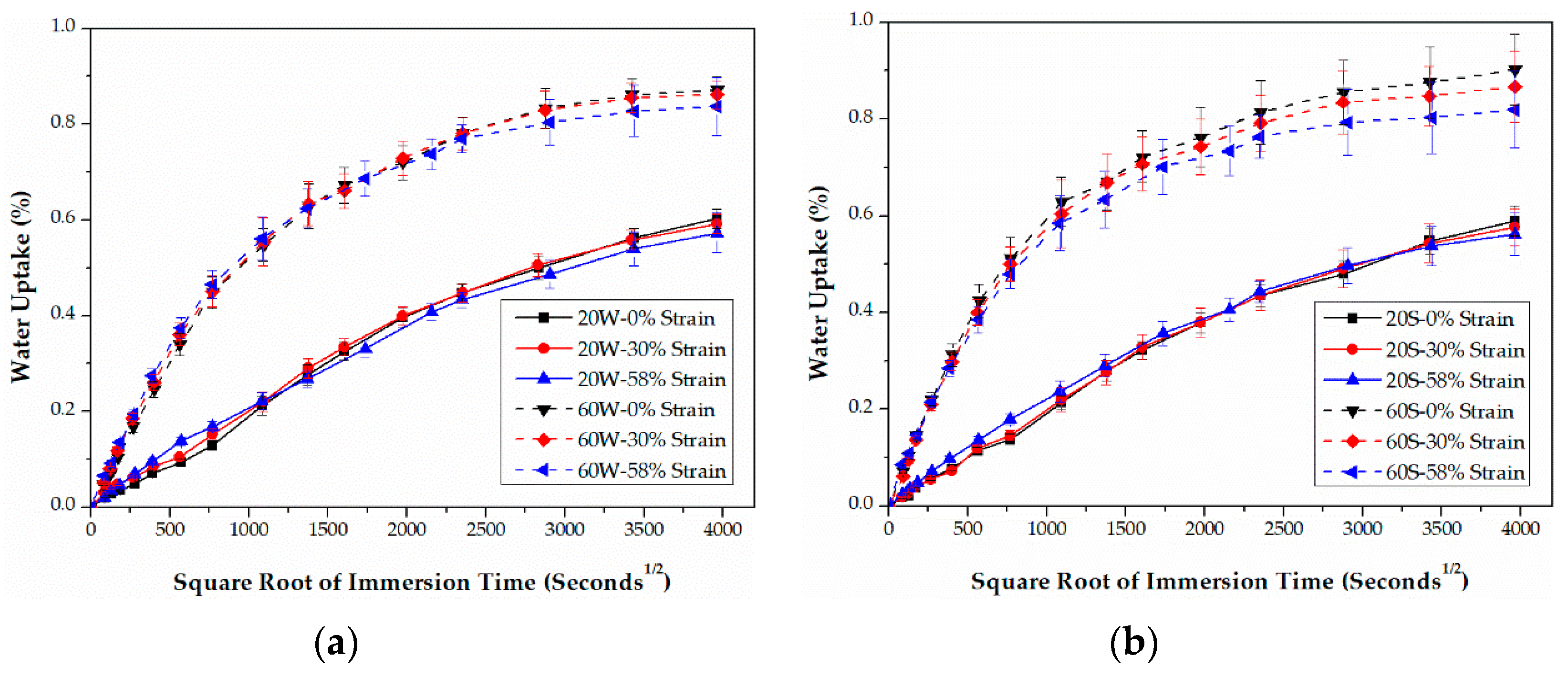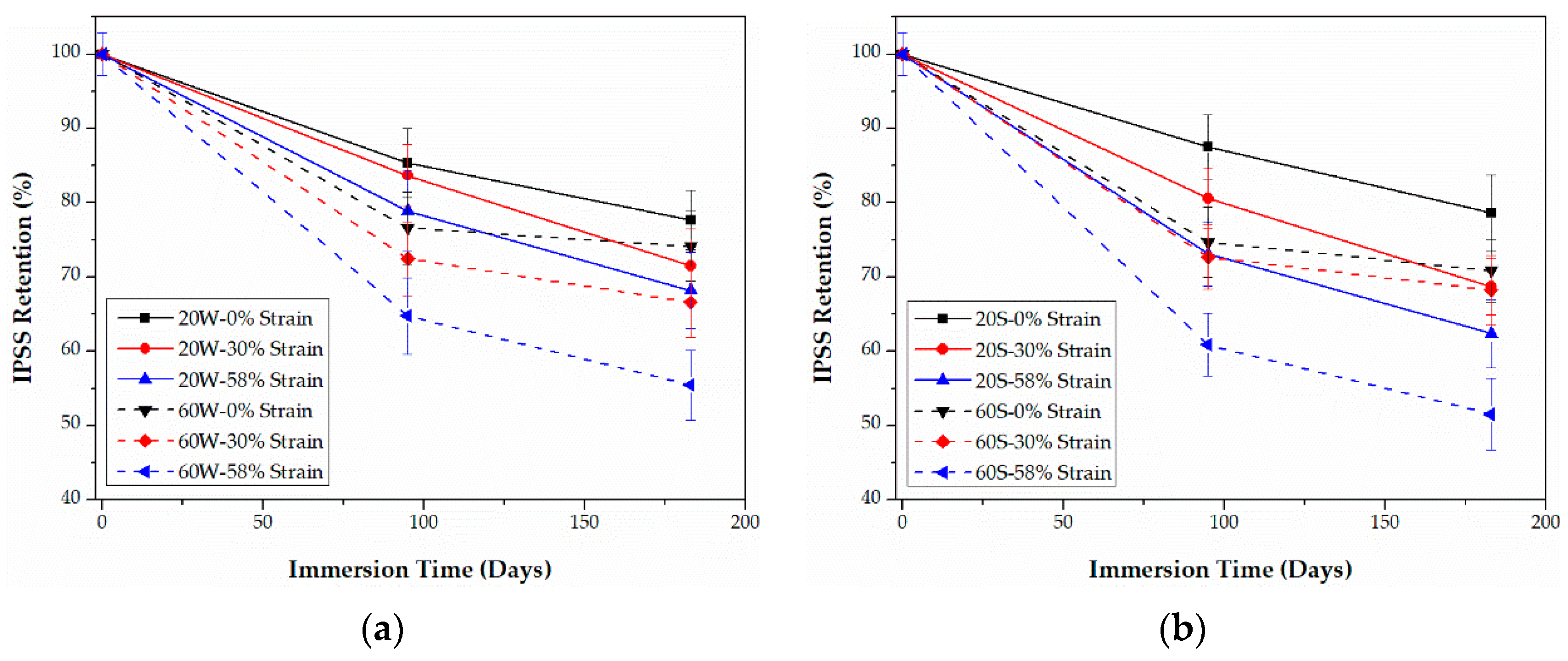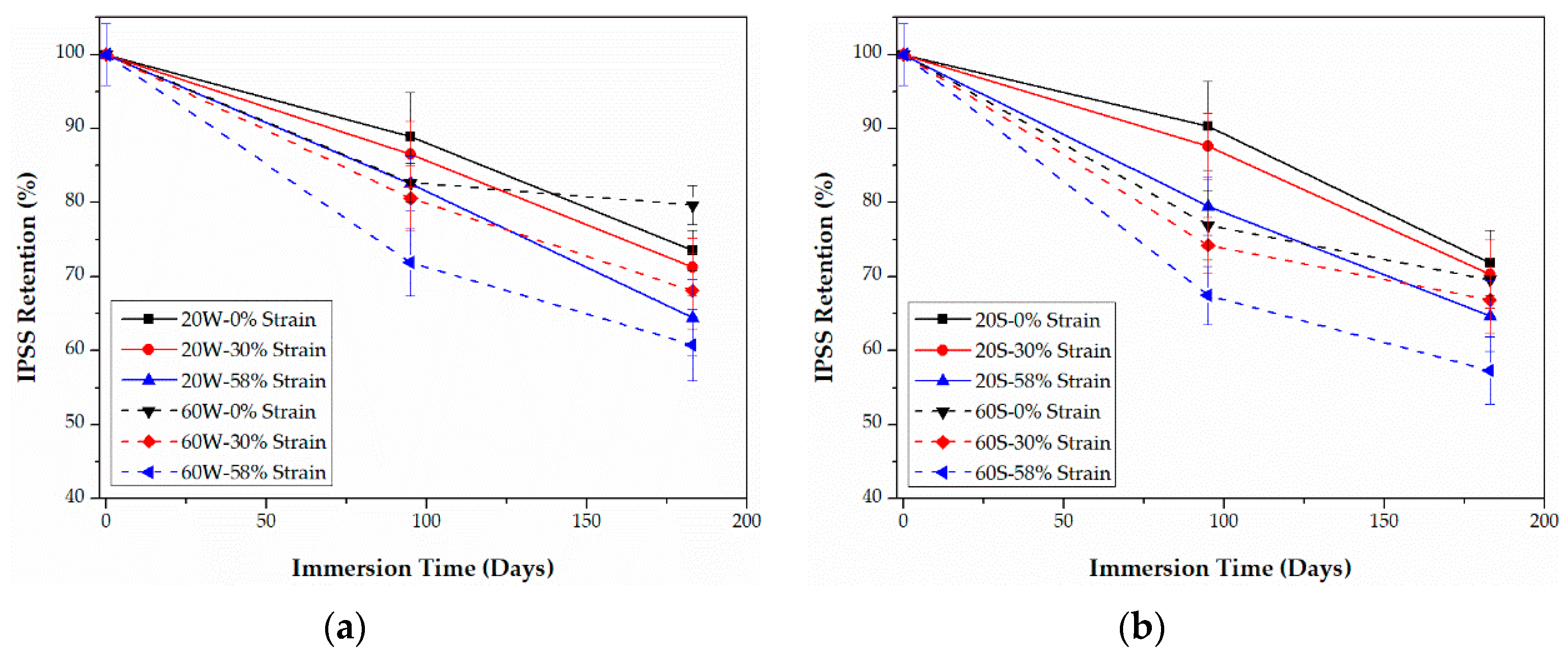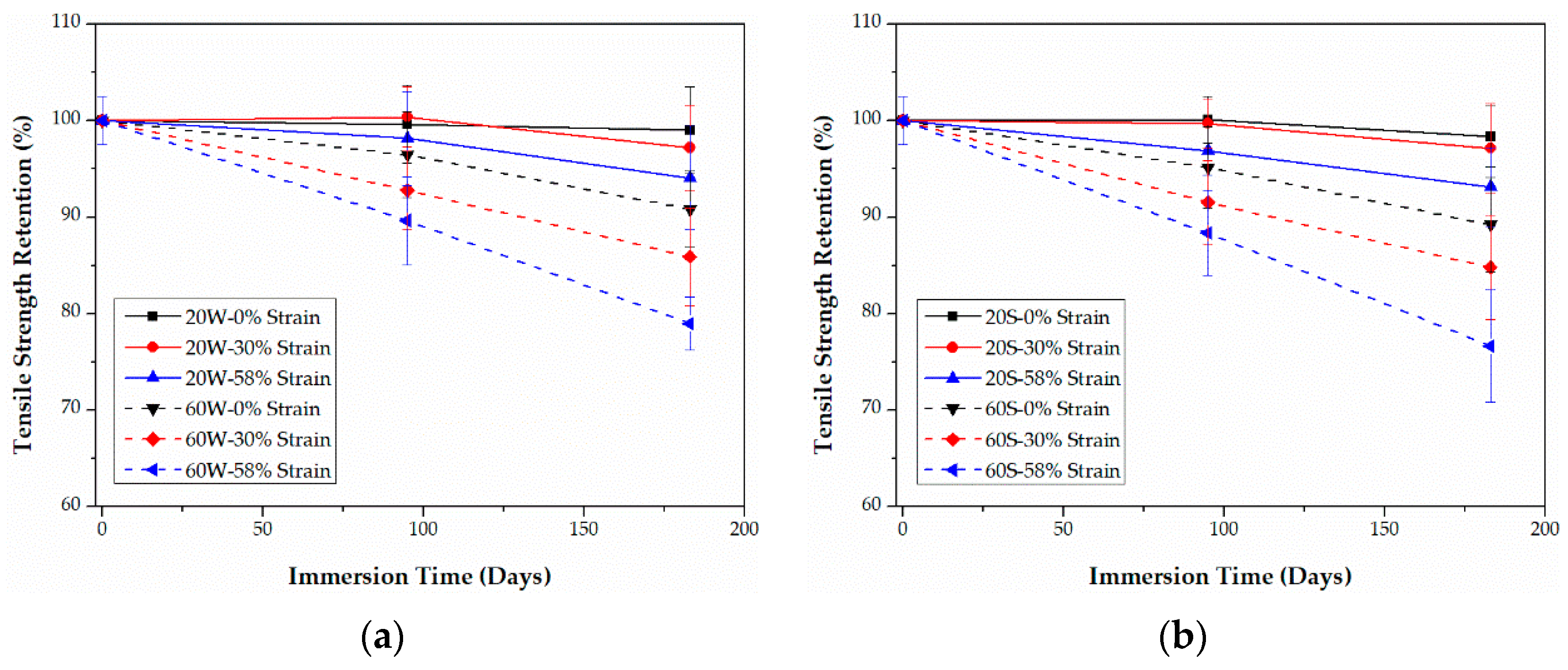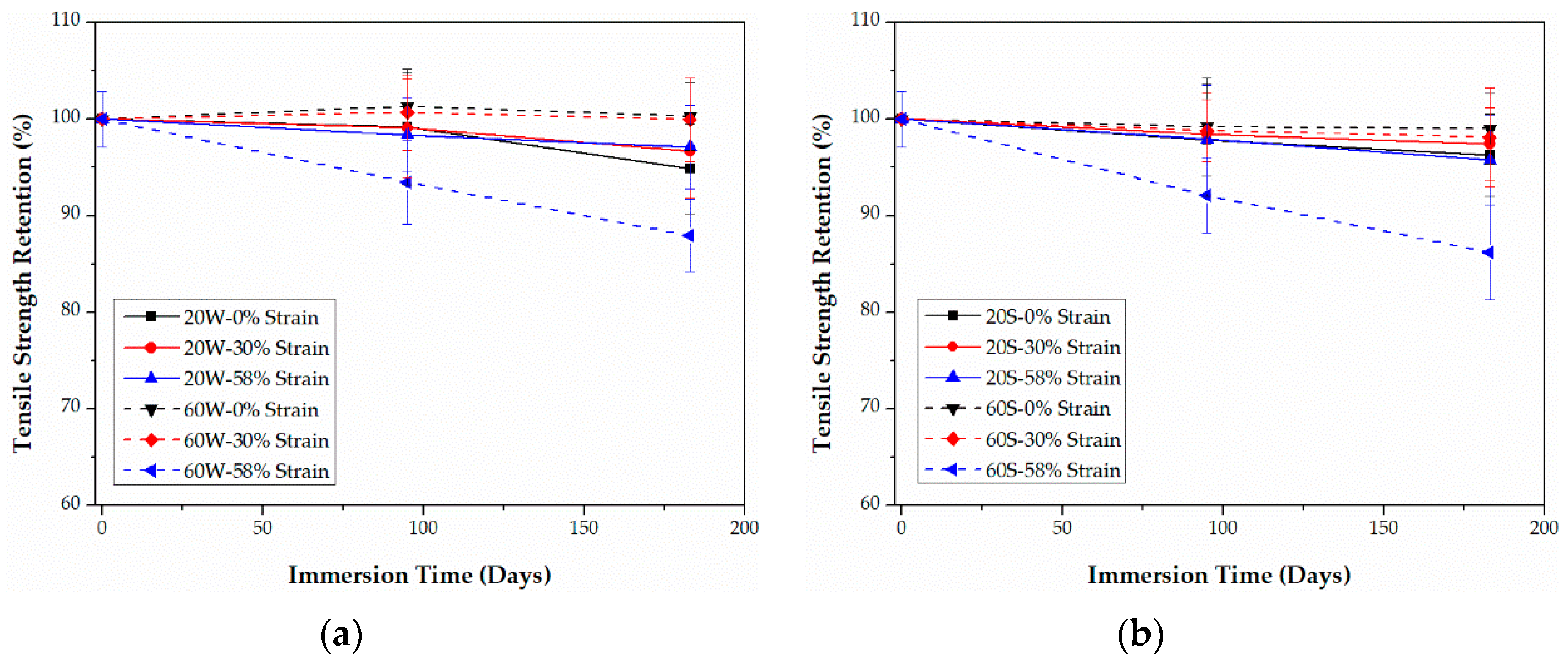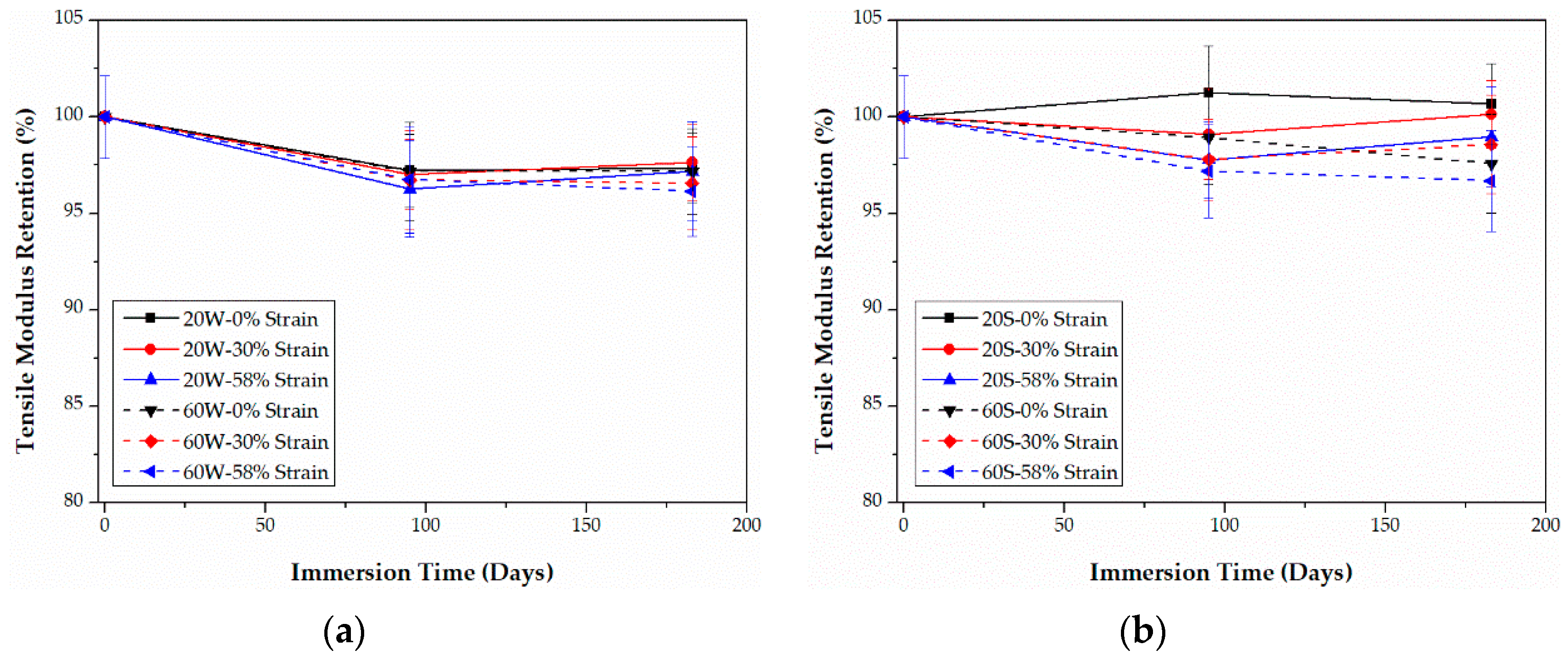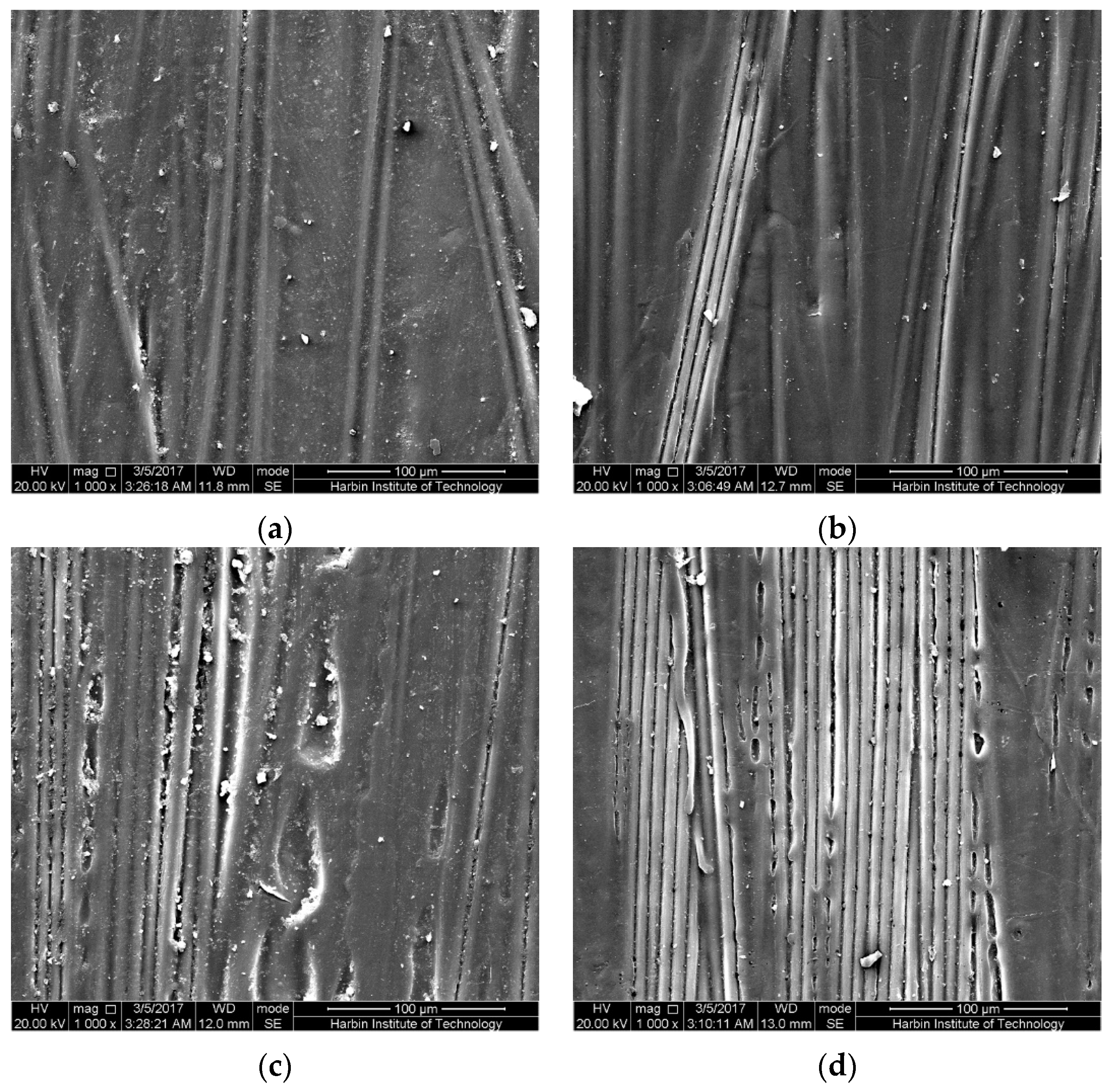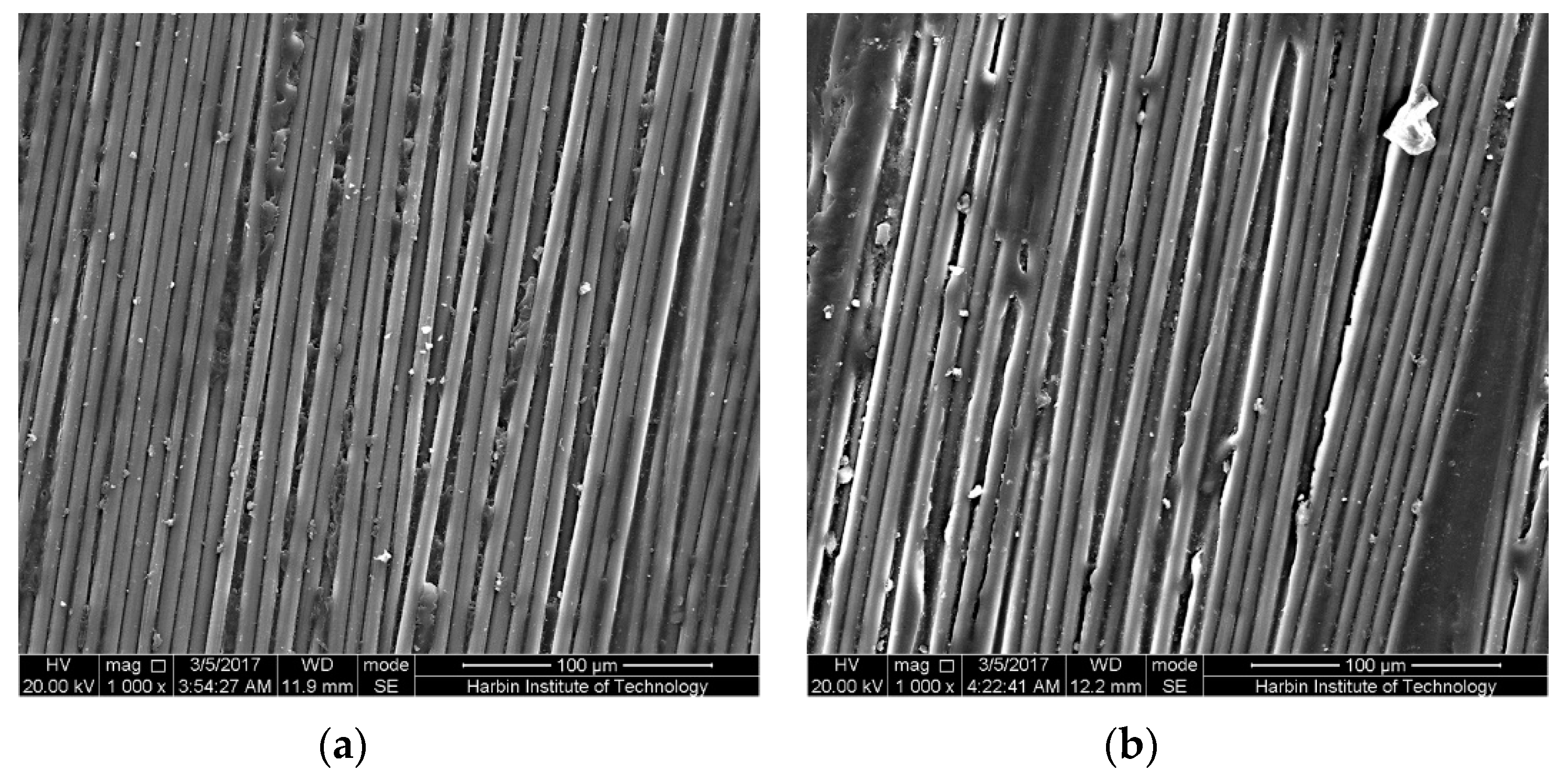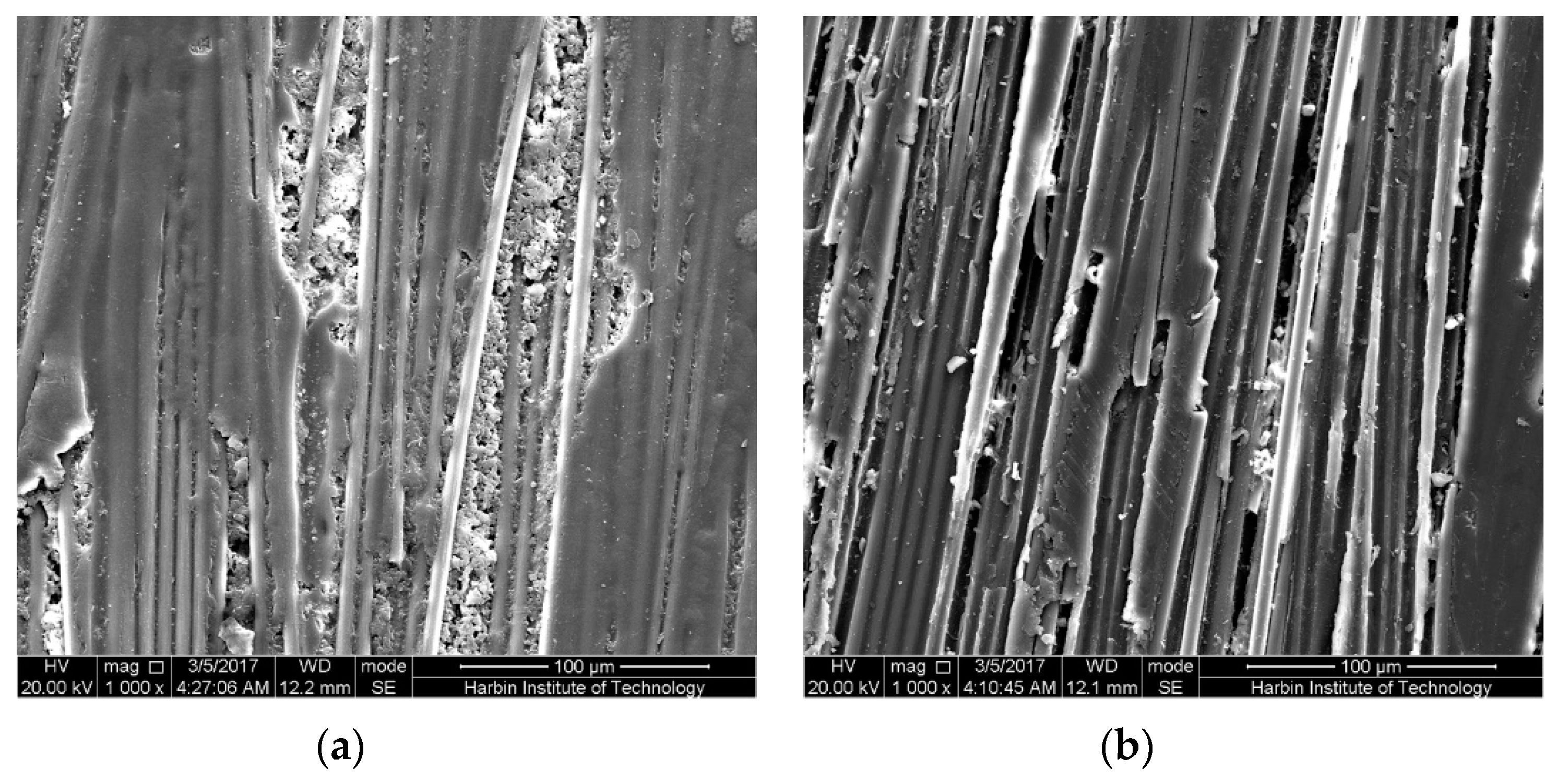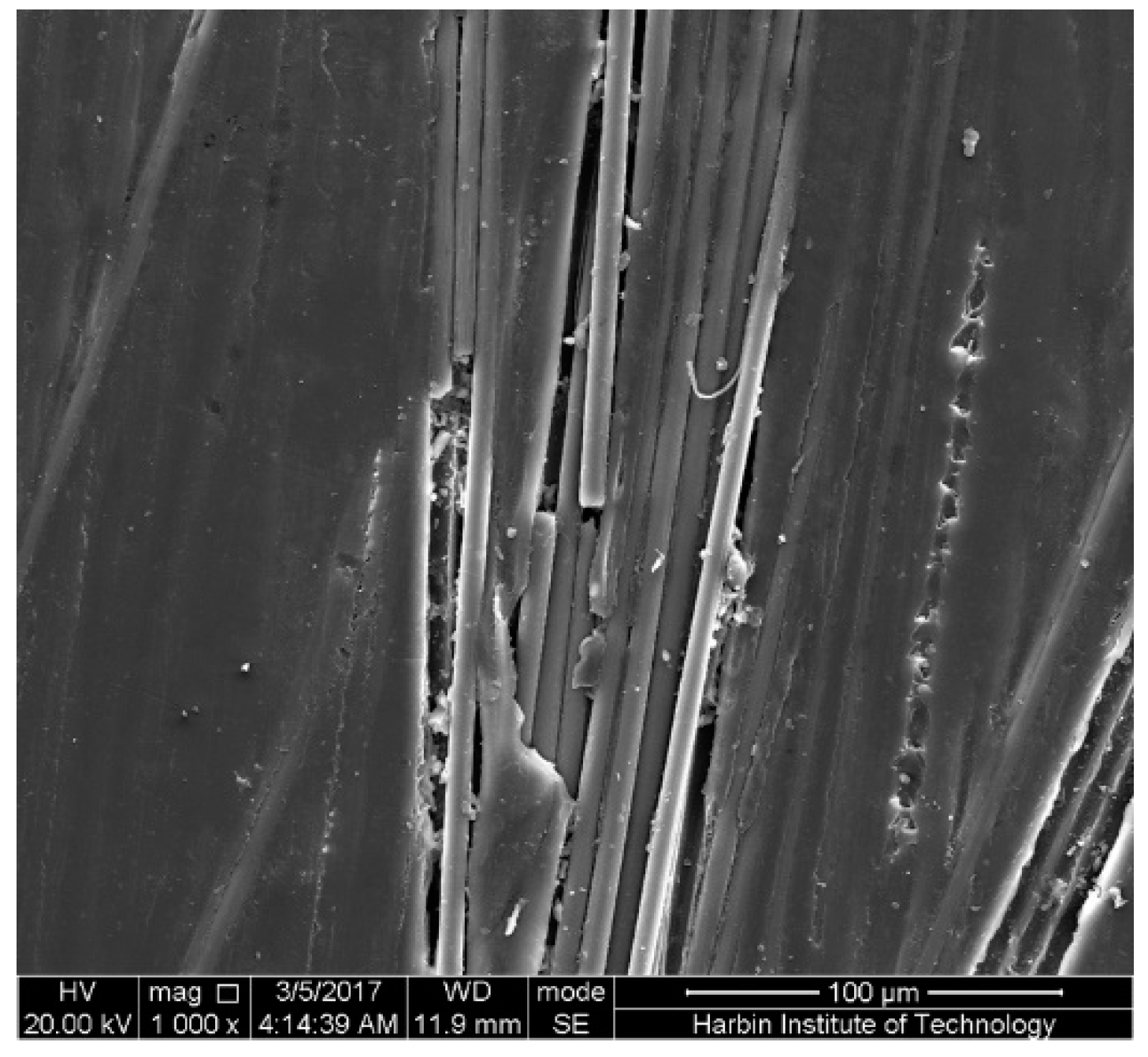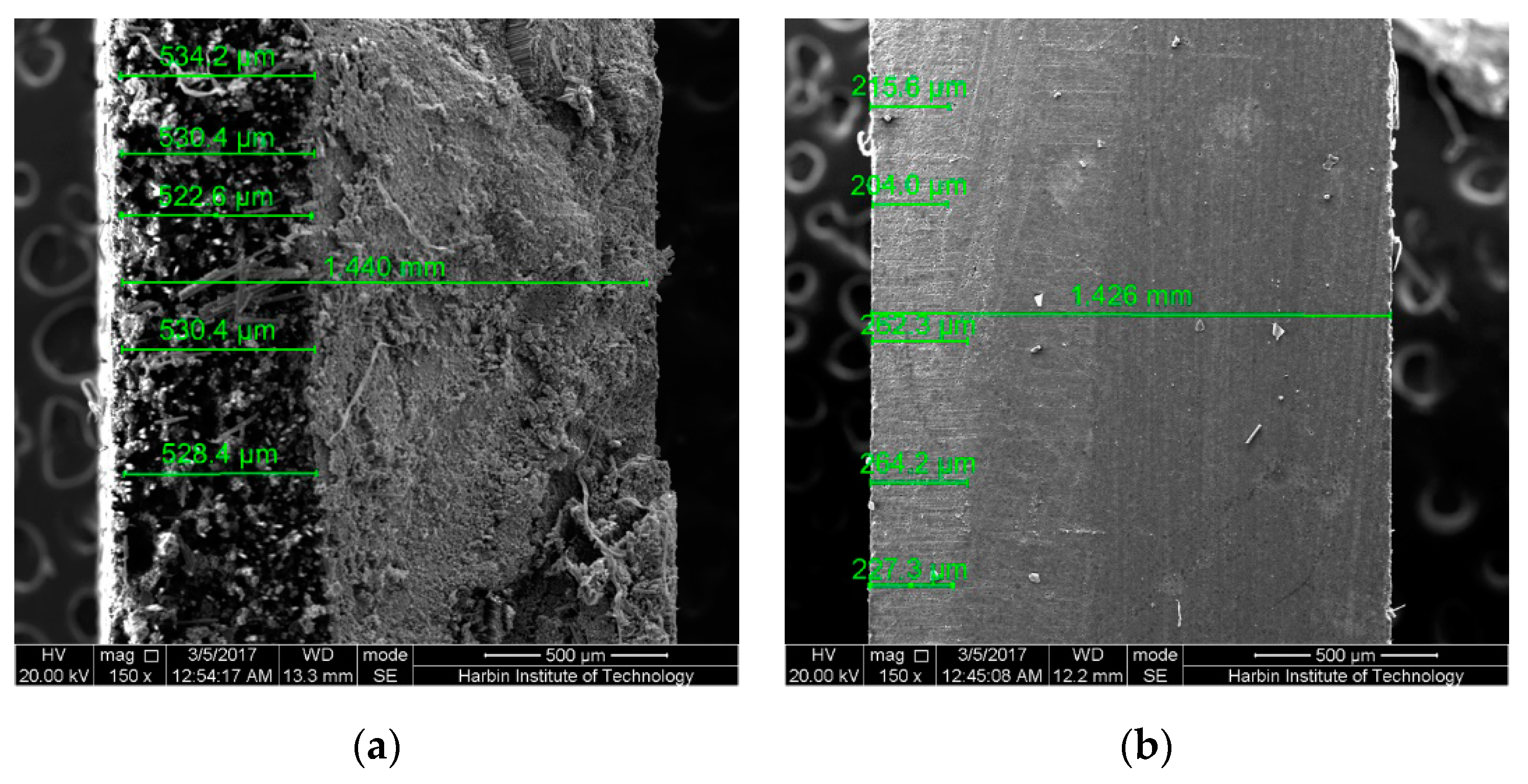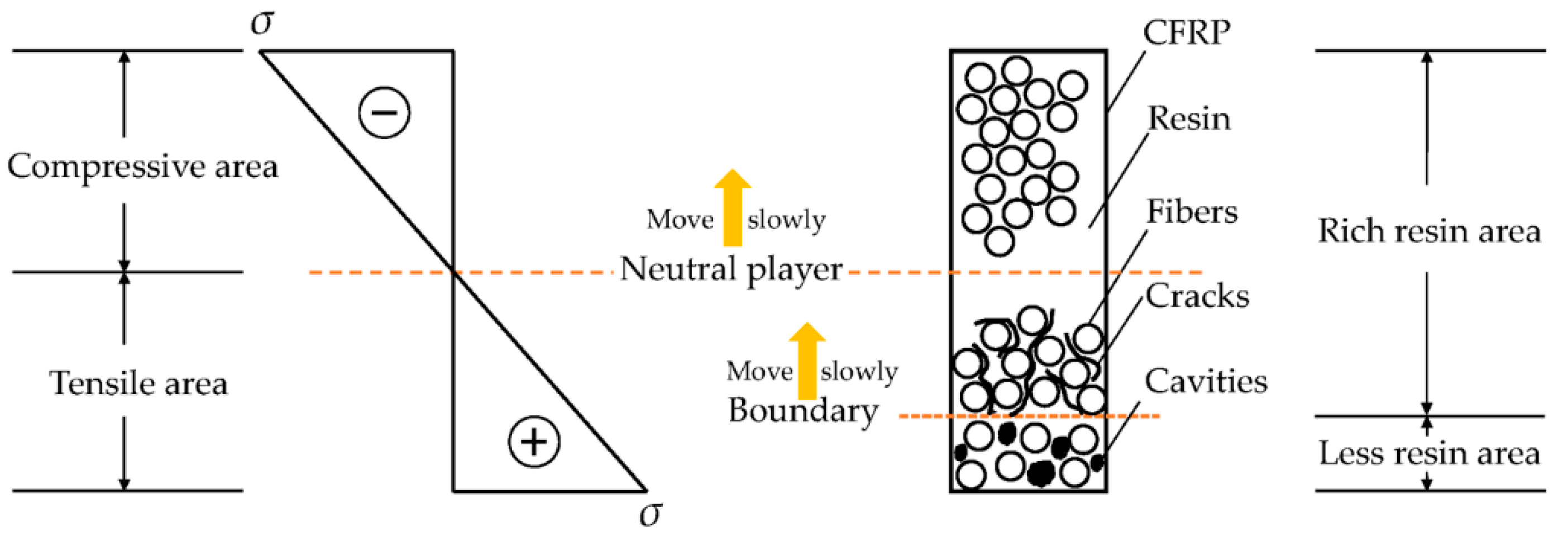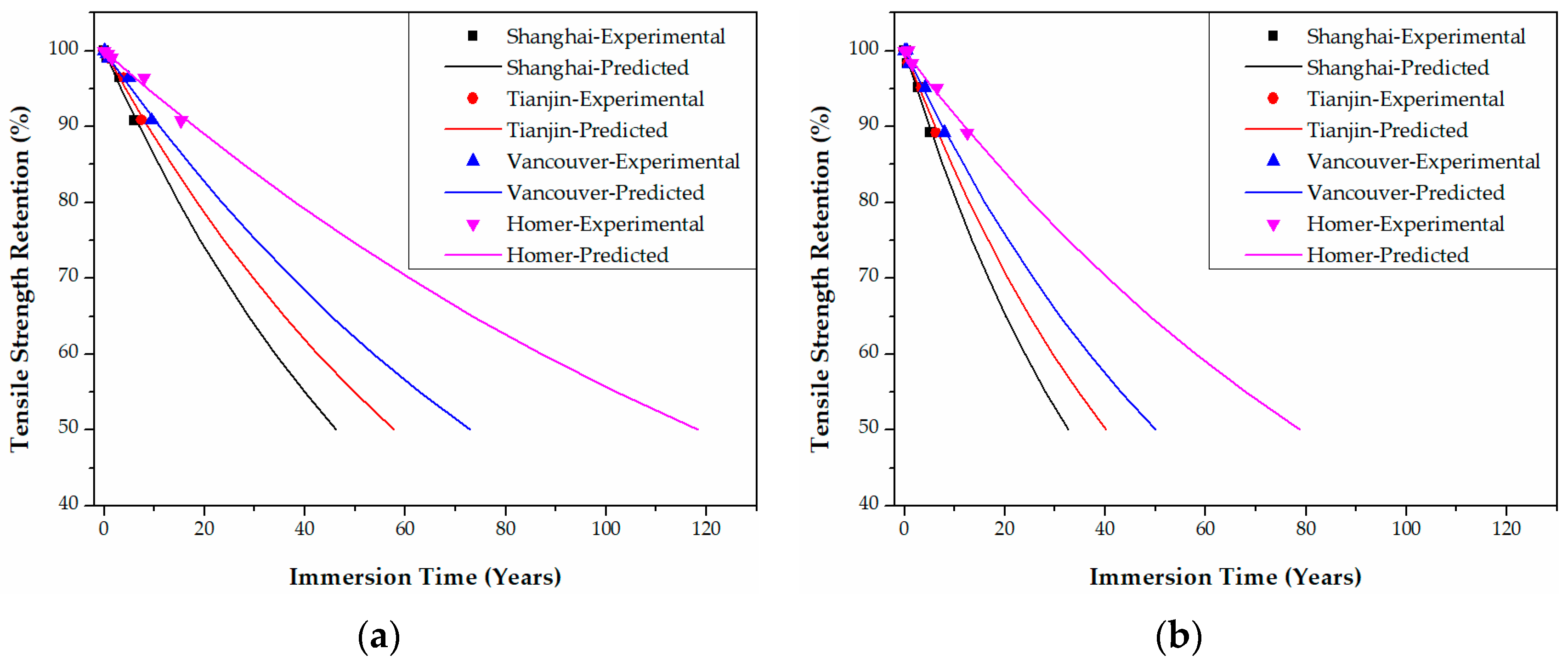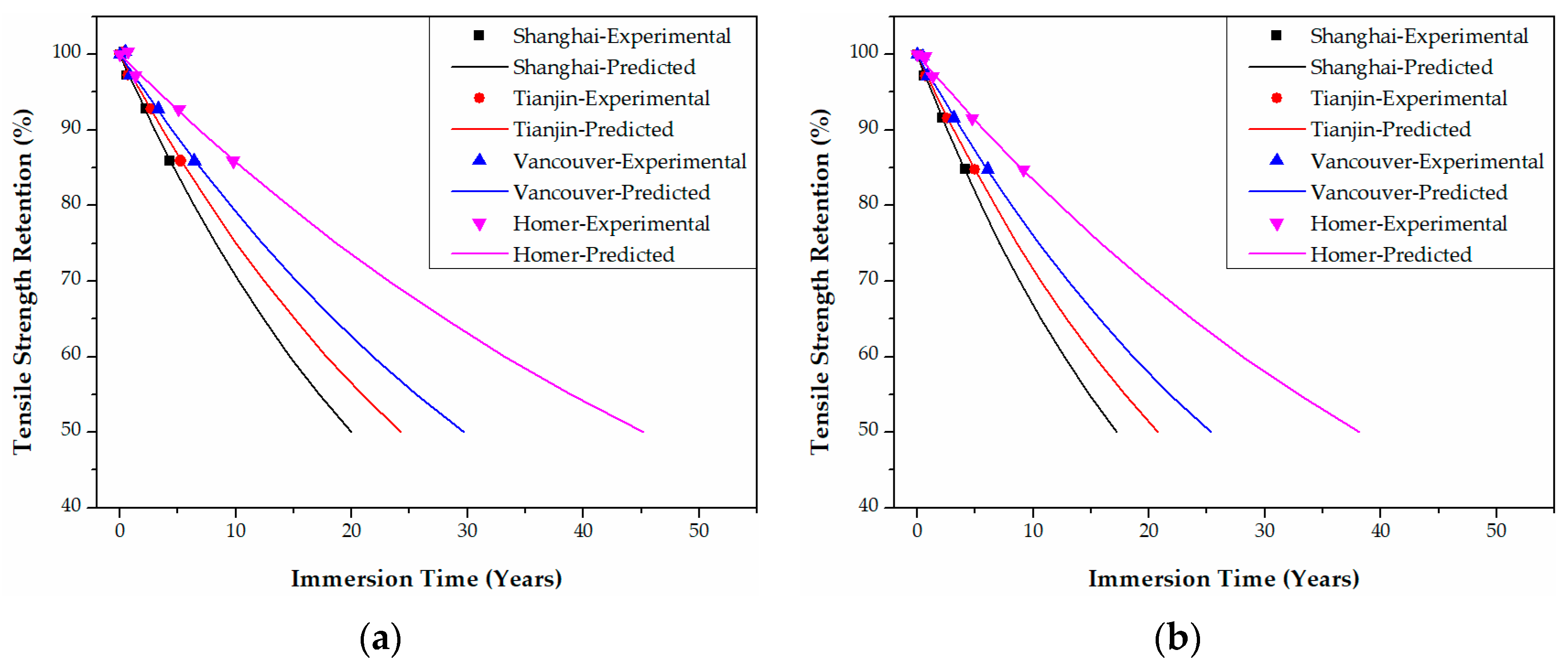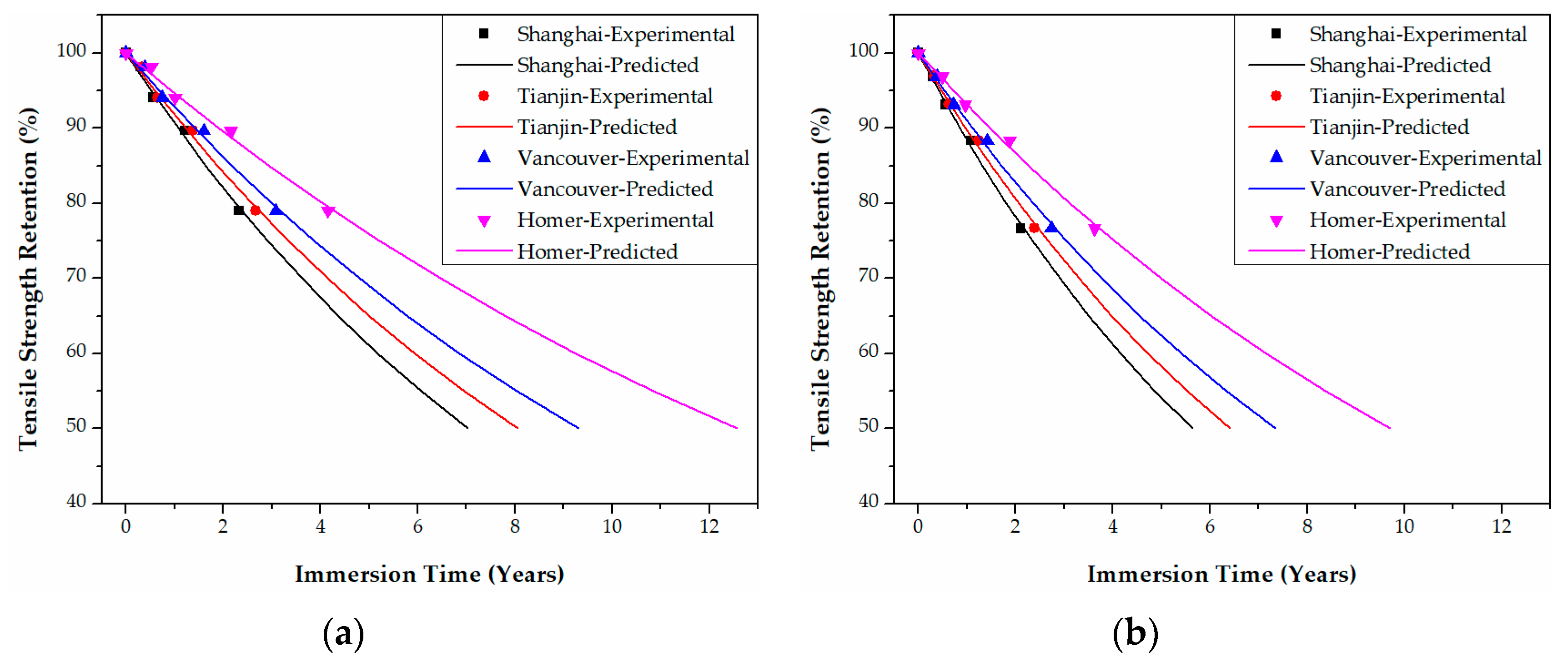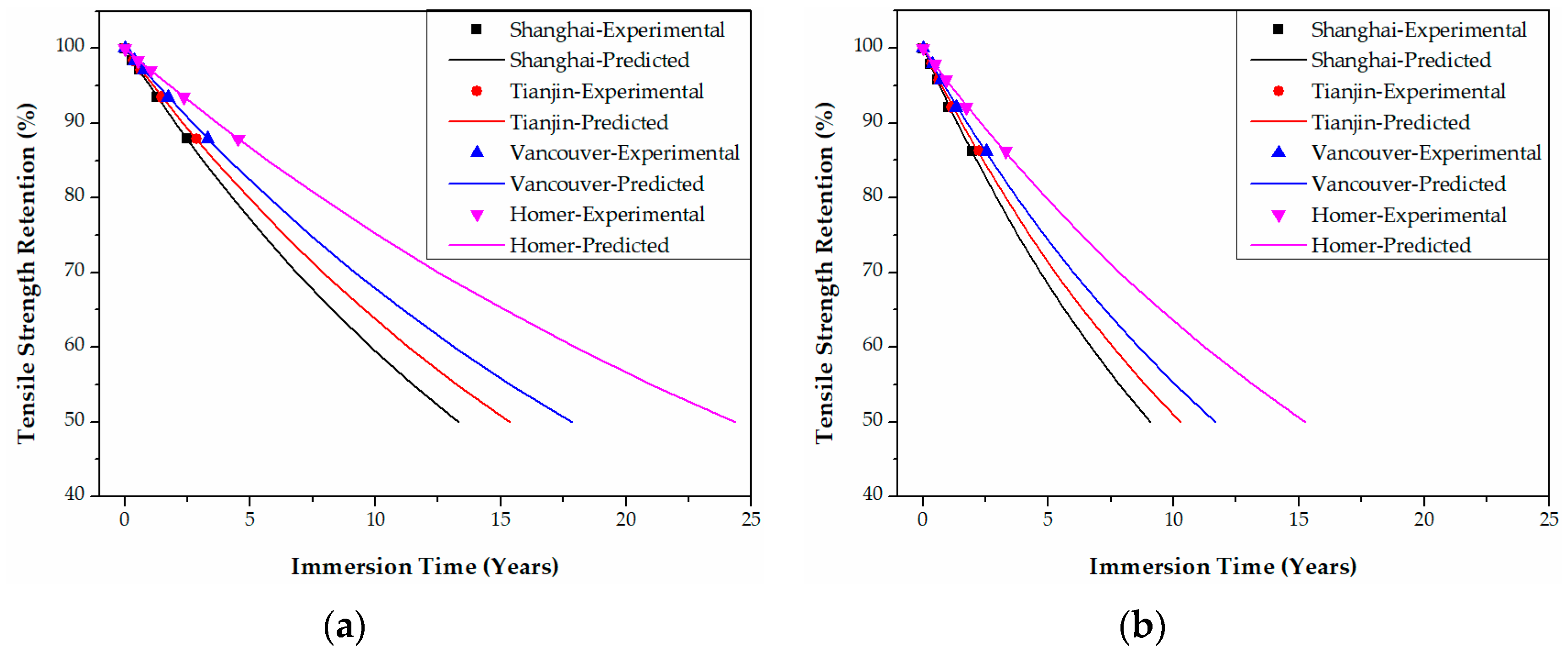Figure 1.
Steel fixture for sustained strain of carbon fiber reinforced polymer (CFRP) plates. (a) Schematic sketch, (b) the coordination system.
Figure 1.
Steel fixture for sustained strain of carbon fiber reinforced polymer (CFRP) plates. (a) Schematic sketch, (b) the coordination system.
Figure 2.
CFRPs under sustained 0%, 30%, and 58% bending strains, respectively. Note, the specimens under sustained 30% and 58% bending strains are placed in the two bending fixtures.
Figure 2.
CFRPs under sustained 0%, 30%, and 58% bending strains, respectively. Note, the specimens under sustained 30% and 58% bending strains are placed in the two bending fixtures.
Figure 3.
Set-up for in-plane shear strength (IPSS) testing. (a) schematic sketch, (b) photograph.
Figure 3.
Set-up for in-plane shear strength (IPSS) testing. (a) schematic sketch, (b) photograph.
Figure 4.
Position of the IPSS testing sample on CFRPs.
Figure 4.
Position of the IPSS testing sample on CFRPs.
Figure 5.
Water uptake curves of epoxy-based CFRPs immersed in distilled water (a) and seawater (b) for 6 months, respectively.
Figure 5.
Water uptake curves of epoxy-based CFRPs immersed in distilled water (a) and seawater (b) for 6 months, respectively.
Figure 6.
Water uptake curves of PU-based CFRPs immersed in distilled water (a) and seawater (b) for 6 months, respectively.
Figure 6.
Water uptake curves of PU-based CFRPs immersed in distilled water (a) and seawater (b) for 6 months, respectively.
Figure 7.
Retention of IPSS of epoxy-based CFRPs immersed in distilled water (a) and seawater (b) for 6 months, respectively.
Figure 7.
Retention of IPSS of epoxy-based CFRPs immersed in distilled water (a) and seawater (b) for 6 months, respectively.
Figure 8.
Retention of IPSS of PU-based CFRPs immersed in distilled water (a) and seawater (b) for 6 months, respectively.
Figure 8.
Retention of IPSS of PU-based CFRPs immersed in distilled water (a) and seawater (b) for 6 months, respectively.
Figure 9.
Retention of the tensile strength of epoxy-based CFRPs immersed in distilled water (a) and seawater (b) for 6 months, respectively.
Figure 9.
Retention of the tensile strength of epoxy-based CFRPs immersed in distilled water (a) and seawater (b) for 6 months, respectively.
Figure 10.
Retention of the tensile strength of PU-based CFRPs immersed in distilled water (a) and seawater (b) for 6 months, respectively.
Figure 10.
Retention of the tensile strength of PU-based CFRPs immersed in distilled water (a) and seawater (b) for 6 months, respectively.
Figure 11.
Retention of the tensile modulus of epoxy-based CFRPs immersed in distilled water (a) and seawater (b) for 6 months, respectively.
Figure 11.
Retention of the tensile modulus of epoxy-based CFRPs immersed in distilled water (a) and seawater (b) for 6 months, respectively.
Figure 12.
Retention of the tensile modulus of PU-based CFRPs immersed in distilled water (a) and seawater (b) for 6 months, respectively.
Figure 12.
Retention of the tensile modulus of PU-based CFRPs immersed in distilled water (a) and seawater (b) for 6 months, respectively.
Figure 13.
The bottom surfaces in the mid-span region of the epoxy-based CFRP samples after 6-month water immersion at 20 °C: (a) controlled samples, (b) the unstrained samples, (c) samples under 30% strain level, (d) samples under 58% strain level.
Figure 13.
The bottom surfaces in the mid-span region of the epoxy-based CFRP samples after 6-month water immersion at 20 °C: (a) controlled samples, (b) the unstrained samples, (c) samples under 30% strain level, (d) samples under 58% strain level.
Figure 14.
The bottom surfaces in the mid-span region of the epoxy-based CFRP samples after 6-month water immersion at 60 °C: (a) the unstrained samples, (b) samples under 58% strain level.
Figure 14.
The bottom surfaces in the mid-span region of the epoxy-based CFRP samples after 6-month water immersion at 60 °C: (a) the unstrained samples, (b) samples under 58% strain level.
Figure 15.
The bottom surfaces in the mid-span region of the epoxy-based CFRP samples subjected to 58% of strain level and seawater immersion for 6 months: (a) 20 °C, (b) 60 °C.
Figure 15.
The bottom surfaces in the mid-span region of the epoxy-based CFRP samples subjected to 58% of strain level and seawater immersion for 6 months: (a) 20 °C, (b) 60 °C.
Figure 16.
The top surface in the mid-span region of the epoxy-based CFRP samples subjected to 58% strain level and seawater immersion at 60 °C for 6 months.
Figure 16.
The top surface in the mid-span region of the epoxy-based CFRP samples subjected to 58% strain level and seawater immersion at 60 °C for 6 months.
Figure 17.
The cross-section in the mid-span region of the broken epoxy-based CFRP samples under 58% of strain level for 6 months: (a) controlled samples, (b) seawater at 20 °C, (c) seawater at 60 °C, (d) water at 60 °C, (e) tension area in water at 60 °C, (f) compression area in water at 60 °C.
Figure 17.
The cross-section in the mid-span region of the broken epoxy-based CFRP samples under 58% of strain level for 6 months: (a) controlled samples, (b) seawater at 20 °C, (c) seawater at 60 °C, (d) water at 60 °C, (e) tension area in water at 60 °C, (f) compression area in water at 60 °C.
Figure 18.
The cross-section in the mid-span region of the PU-based CFRP samples under 58% strain level for 6 months: (a) broken samples in seawater at 60 °C, (b) unbroken samples in seawater at 60 °C.
Figure 18.
The cross-section in the mid-span region of the PU-based CFRP samples under 58% strain level for 6 months: (a) broken samples in seawater at 60 °C, (b) unbroken samples in seawater at 60 °C.
Figure 19.
Schematic sketch of the effects of sustained bending on CFRPs immersed in water/seawater in the long run.
Figure 19.
Schematic sketch of the effects of sustained bending on CFRPs immersed in water/seawater in the long run.
Figure 20.
Life prediction of the tensile strength for unstrained epoxy-based CFRPs immersed in distilled water (a) and seawater (b) in the four cities, respectively.
Figure 20.
Life prediction of the tensile strength for unstrained epoxy-based CFRPs immersed in distilled water (a) and seawater (b) in the four cities, respectively.
Figure 21.
Life prediction of the tensile strength for epoxy-based CFRPs (30% strain) immersed in distilled water (a) and seawater (b) in the four cities, respectively.
Figure 21.
Life prediction of the tensile strength for epoxy-based CFRPs (30% strain) immersed in distilled water (a) and seawater (b) in the four cities, respectively.
Figure 22.
Life prediction of the tensile strength for epoxy-based CFRPs (58% strain) immersed in distilled water (a) and seawater (b) in the four cities, respectively.
Figure 22.
Life prediction of the tensile strength for epoxy-based CFRPs (58% strain) immersed in distilled water (a) and seawater (b) in the four cities, respectively.
Figure 23.
Life prediction of the tensile strength for PU-based CFRPs (58% strain) immersed in distilled water (a) and seawater (b) in the four cities, respectively.
Figure 23.
Life prediction of the tensile strength for PU-based CFRPs (58% strain) immersed in distilled water (a) and seawater (b) in the four cities, respectively.
Table 1.
Mechanical properties of epoxy- and polyurethane (PU)-based carbon fiber reinforced polymers (CFRPs).
Table 1.
Mechanical properties of epoxy- and polyurethane (PU)-based carbon fiber reinforced polymers (CFRPs).
| Mechanical properties | Epoxy-based CFRPs | PU-based CFRPs |
|---|
| In-plane shear strength (IPSS) (MPa) | 75.18 ± 2.15 | 80.41 ± 3.32 |
| Tensile strength (GPa) | 2.15 ± 0.05 | 2.21 ± 0.06 |
| Tensile modulus (GPa) | 165.25 ± 3.54 | 172.26 ± 3.09 |
| Tensile elongation at break (%) | 1.30 ± 0.05 | 1.29 ± 0.08 |
Table 2.
Water diffusion parameters of epoxy- and PU-based CFRPs in water or seawater, respectively.
Table 2.
Water diffusion parameters of epoxy- and PU-based CFRPs in water or seawater, respectively.
| CFRPs | Parameters | Immersion temperature (°C) | 20 | 60 |
|---|
| Strain level (%) | 0 | 30 | 58 | 0 | 30 | 58 |
|---|
| Epoxy-based CFRPs | Mmax (%) | Water | 0.25 | 0.24 | 0.23 | 0.49 | 0.50 | 0.47 |
| Seawater | 0.24 | 0.23 | 0.21 | 0.50 | 0.49 | 0.46 |
| D (×10−8 mm2/s) | Water | 4.41 | 4.55 | 7.53 | 13.74 | 15.62 | 16.81 |
| Seawater | 3.67 | 4.63 | 12.32 | 15.64 | 17.78 | 20.39 |
| PU-based CFRPs | Mmax (%) | Water | 0.60 | 0.59 | 0.57 | 0.87 | 0.86 | 0.84 |
| Seawater | 0.59 | 0.57 | 0.56 | 0.90 | 0.87 | 0.82 |
| D (×10−8 mm2/s) | Water | 3.43 | 5.20 | 7.72 | 20.34 | 24.31 | 27.92 |
| Seawater | 4.87 | 5.29 | 8.25 | 30.09 | 30.08 | 32.82 |
Table 3.
Coefficients of regression equation in Equation (21).
Table 3.
Coefficients of regression equation in Equation (21).
| CFRP plates | Strain level (%) | Temperature (°C) | Distilled water | Seawater |
|---|
| τ | R2 | τ | R2 |
|---|
| Epoxy-based CFRPs | 0 | 20 | 20,013.2 | 0.97 | 14,276.4 | 0.64 |
| 60 | 2032.9 | 0.56 | 1665.1 | 0.77 |
| 30 | 20 | 8873.6 | 0.93 | 7668.7 | 0.99 |
| 60 | 1219.3 | 0.97 | 1100.8 | 0.99 |
| 58 | 20 | 3287.1 | 0.99 | 2659.0 | 0.99 |
| 60 | 800.0 | 0.99 | 709.2 | 0.99 |
| PU-based CFRPs | 58 | 20 | 6178.3 | 0.99 | 4294.1 | 0.99 |
| 60 | 1420.2 | 0.99 | 1214.8 | 0.99 |
Table 4.
Coefficients of regression equation in Equation (23).
Table 4.
Coefficients of regression equation in Equation (23).
| CFRP plates | Strain level (%) | Distilled water | Seawater |
|---|
| Ea (kJ/mol) | R2 | Ea (kJ/mol) | R2 |
|---|
| Epoxy-based CFRPs | 0 | 46.4 | 0.99 | 43.6 | 0.99 |
| 30 | 40.3 | 0.99 | 39.4 | 0.99 |
| 58 | 28.7 | 0.99 | 26.8 | 0.99 |
| PU-based CFRPs | 58 | 29.9 | 0.99 | 25.6 | 0.99 |
Table 5.
Time-shift factors of both epoxy- and PU-based CFRPs immersed in distilled water.
Table 5.
Time-shift factors of both epoxy- and PU-based CFRPs immersed in distilled water.
| CFRP plates | Strain level (%) | Temperature (°C) | Shanghai 17.0 °C a | Tianjin 13.7 °C a | Vancouver 10.3 °C b | Homer 3.5 °C c |
|---|
| Epoxy-based CFRPs | 0 | 20 | 1.2 | 1.5 | 1.9 | 3.1 |
| 60 | 12.0 | 15.0 | 18.9 | 30.7 |
| 30 | 20 | 1.2 | 1.4 | 1.8 | 2.7 |
| 60 | 8.6 | 10.5 | 12.8 | 19.5 |
| 58 | 20 | 1.1 | 1.3 | 1.5 | 2.0 |
| 60 | 4.6 | 5.3 | 6.1 | 8.3 |
| PU-based CFRPs | 58 | 20 | 1.1 | 1.3 | 1.5 | 2.1 |
| 60 | 4.9 | 5.7 | 6.6 | 9.0 |
Table 6.
Time-shift factors of both epoxy- and PU-based CFRPs immersed in seawater.
Table 6.
Time-shift factors of both epoxy- and PU-based CFRPs immersed in seawater.
| CFRP plates | Strain level (%) | Temperature (°C) | Shanghai 17.0 °C | Tianjin 13.7 °C | Vancouver 10.3 °C | Homer 3.5 °C |
|---|
| Epoxy-based CFRPs | 0 | 20 | 1.2 | 1.5 | 1.8 | 2.9 |
| 60 | 10.3 | 12.7 | 15.8 | 24.9 |
| 30 | 20 | 1.2 | 1.4 | 1.7 | 2.6 |
| 60 | 8.2 | 9.9 | 12.1 | 18.3 |
| 58 | 20 | 1.1 | 1.3 | 1.5 | 1.9 |
| 60 | 4.2 | 4.8 | 5.5 | 7.2 |
| PU-based CFRPs | 58 | 20 | 1.1 | 1.3 | 1.4 | 1.9 |
| 60 | 3.9 | 4.5 | 5.1 | 6.6 |
Table 7.
τ (R2 ≥0.98) of regression equation in Equation (21) for the life prediction curves.
Table 7.
τ (R2 ≥0.98) of regression equation in Equation (21) for the life prediction curves.
| CFRP plates | Media | Strain level (%) | Shanghai 17.0 °C | Tianjin 13.7 °C | Vancouver 10.3 °C | Homer 3.5 °C |
|---|
| Epoxy-based CFRPs | Water | 0 | 24,369.4 | 30,408.4 | 38,405.8 | 62,327.8 |
| 30% | 10,527.6 | 12,757.9 | 15,623.8 | 23,784.5 |
| 58% | 3704.8 | 4247.9 | 4907.2 | 6618.7 |
| Seawater | 0 | 17,178.4 | 21,150.5 | 26,338.9 | 41,512.4 |
| 30% | 9063.9 | 10,937.7 | 13,335.1 | 20,113.4 |
| 58% | 2972.0 | 3377.7 | 3865.6 | 5113.6 |
| PU-based CFRPs | Water | 58% | 7012.2 | 8084.8 | 9394.2 | 12,824.8 |
| Seawater | 58% | 4787.3 | 5409.8 | 6154.1 | 8040.3 |
Table 8.
Service lives (years), required for the tensile strength retention to reach 50%, of both epoxy- and PU-based CFRPs in various conditions in the four cities.
Table 8.
Service lives (years), required for the tensile strength retention to reach 50%, of both epoxy- and PU-based CFRPs in various conditions in the four cities.
| CFRP plates | Media | Strain level (%) | Shanghai 17.0 °C | Tianjin 13.7 °C | Vancouver 10.3 °C | Homer 3.5 °C |
|---|
| Epoxy-based CFRPs | Water | 0 | 46.3 | 57.7 | 72.9 | 118.4 |
| 30% | 20.0 | 24.2 | 29.7 | 45.2 |
| 58% | 7.0 | 8.1 | 9.3 | 12.6 |
| Seawater | 0 | 32.6 | 40.2 | 50.0 | 78.8 |
| 30% | 17.2 | 20.8 | 25.3 | 38.2 |
| 58% | 5.6 | 6.4 | 7.3 | 9.7 |
| PU-based CFRPs | Water | 58% | 13.3 | 15.4 | 17.8 | 24.4 |
| Seawater | 58% | 9.1 | 10.3 | 11.7 | 15.3 |

